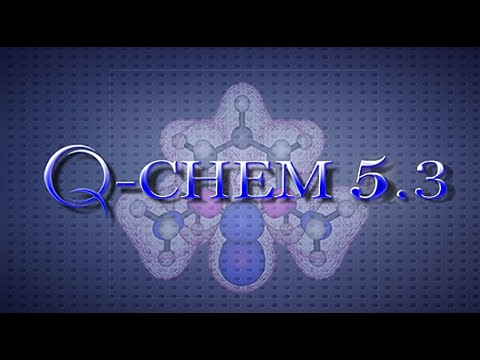We are happy to announce Q-Chem 5.3 released on June 16, 2020!
Q-Chem 5.3 release log
Changes in Default Settings
- Renamed rem variable ADIABATIC_CTA to VFB_CTA
- Changed ROHF_DIAG_SPEC default from 0 to 2 for ROHF and set GEN_SCFMAN as default ROSCF engine
New Features and Methods
- General improvements:
- Added support for the jun-cc-pvdz basis set (K. Carter-Fenk)
- New features and improvements to the DFT capabilities:
- TD-DFT analytic force and frequencies for meta-GGA density functionals
- Level shifting in DIIS for better SCF convergence in difficult cases
- M06-SX density functional (P. Morgante, R. Peverati)
- HF-3c method (B. Rana, J. Herbert)
- New features and improvements in the CC/EOM-CC package:
- Calculation of RIXS and orbital analysis of RIXS transition moments (K. Nanda, A.I. Krylov)
- New features in the CVS-EOM-CC suite (M. Vidal, S. Coriani)
- Energies and properties for EOM-DEA-CCSD (S. Gulania, M. Ivanov, A.I. Krylov)
- Transition properties and S2 for EOM-DIP-CCSD (S. Gulania, W. Skomorowski, A.I. Krylov)
- New NLO properties (hyperpolarizabilities) in EOM-CC (K. Nanda, A.I. Krylov)
- New tools for strongly correlated and magnetic systems: Extention of FNO to open-shell systems (P. Pokhilko, A.I. Krylov)
- Construction of effective Hamiltonians from EOM-CC wavefunctions (P. Pokhilko, A.I. Krylov)
- NTO analysis of spin-forbidden transitions (P. Pokhilko, A.I. Krylov)
- Search for special points of complex PES (minima, MECP, and exceptional points) within CAP-EOM-CCSD (Z. Benda, T.-C. Jagau)
- Voronoi CAP and projected CAP methods (J. Gayvert, K. Bravaya)
- New tools for computing Auger decay rates and resonance lifetimes by the Feshbach-Dyson method (W. Skomorowski, A.I. Krylov)
- Stability improvements in EOM-CC (P. Pokhilko, A.I. Krylov)
- New features and improvements in MP2 methods:
- Geometry optimization with regularized orbital-optimized second-order Moller-Plesset perturbation theory (kappa-OOMP2) (Joonho Lee, M. Head-Gordon)
- New capabilities for intermolecular interactions:
- Implementation of the XSAPT+MBD method (K. Carter-Fenk, J. Herbert)
- QM/MM improvements:
- L-BFGS algorithm for geometry optimization (B. Rana and J. Herbert)
- Harmonic confining potentials (S. Dasgupta and J. Herbert)
- New methods and capabilities:
- Nuclear electronic orbital DFT and TD-DFT methods (F. Pavosevic, Zhen Tao, S. Hammes-Schiffer)
- New module for RAS-SF methods (S. Houck, N. Mayhall)
- A family of configuration-interaction methods: non-orthogonal configuration interaction singles (NOCIS), static exchange (STEX), and one-center NOCIS (K. Oosterbaan, M. Head-Gordon)
- Integral screening and resolution-of-the-identity capabilities for complex basis functions (T.-C. Jagau)
- RI-MP2 method for complex basis functions (M. Hernandez Vera, T.-C. Jagau)
- New method (concentric localization) for truncating the virtual space in projector-based embedding theory (Yuezhi Mao)
- Square gradient minimization for excited state orbital optimization (D. Hait, M. Head-Gordon)
- Resonance Raman spectroscopy simulation (S. Dasgupta, B. Rana, J. Herbert)
- Population analysis of antibonding orbitals (A. Aldossary)
- Fragment-based diabatization schemes (Yuezhi Mao)
- Enabled ghost atoms without basis functions (B. Alam and J. Herbert)
- Electron localization function (A. Bushra, J. Herbert)
- New input options for wavefunction analysis (F. Plasser)
- New features of the BrianQC GPU module:
- Extended support for GPU accelerated DFT exchange-correlation with support for LDA, GGA, and meta-GGA functionals
- Partially GPU accelerated DFT frequency calculations
Other Fixes and Improvements
- Added NTO/NBO plots for multiple CIS/TDDFT states with the new format of $plots input section
- Added capability to produce AIMPAC WFN files in GEN_SCFMAN (J. Herbert)
- Improved readability of SAPT output (J. Herbert)
- Added spin density plots capability using ALMO-EDA (Yuezhi Mao)
- Added visualization of fragment orbitals using ALMO-EDA (Yuezhi Mao)
- Resolved a numerical problem with zero initial gradient in the GDM algorithm for SCF (Yuezhi Mao)
- Resolved an issue with SCF convergence during geometry optimization with SM8 (Yuezhi Mao)
- Resolved an issue with frozen active-space ROHF calculation giving inconsistent results (Yuezhi Mao)
- Resolved an issue causing not-a-number errors when evaluating empirical D3 corrections
- Resolved multiple issues with the Poisson-Boltzmann solver (C. Stein)
- Resolved an issue with the normalization of vectors in CVS-EOMIP-CCSD (P. Pokhilko and A.I. Krylov)
- Resolved an issue preventing the computation of CCSD to EOM-EE transition properties (P. Pokhilko)
- Resolved an issue with unrestricted EOM-DIP transition properties (P. Pokhilko)
- Resolved EOM convergence issues due to violation of permutational symmetry (P. Pokhilko)
- Resolved an issue with EOM two-photon absorption due to an incorrect prefactor in the response equation (K. Nanda)
- Resolved an issue with evaluating Hirshfeld charges for open-shell systems with basis sets containing high angular momentum functions (Yuezhi Mao)
- Resolved an issue that caused SOS-ADC(2) computations to crash
- Resolved issues with using user-specified MM force field parameter file
- Resolved an issue preventing BSSE computations from properly executing (Yuezhi Mao)
- Resolved an issue causing incorrect SM12/CM5 solvation energies (Yuezhi Mao; note: only development versions of Q-Chem were affected by this issue)
- Resolved an issue with ghost atoms in PCM calculations (Yuezhi Mao)
- Resolved an issue with wavefunction analysis in QM/MM (J. Herbert)
- Resolved an issue with missing MM energies in QM/MM calculations (Yuezhi Mao)
- Resolved multiple issues in ALMO-EDA (Yuezhi Mao)
- Resolved an issue causing ALMO-EDA computations to terminate abnormally on Windows
- Restored the behavior of EDA_ALIGN_FRGM_SPIN as documented (Yuezhi Mao)
